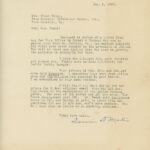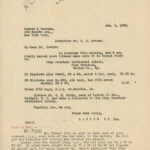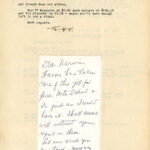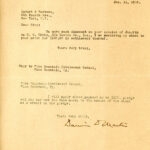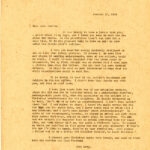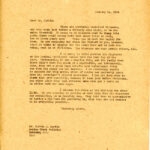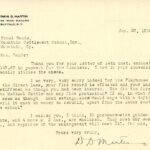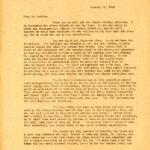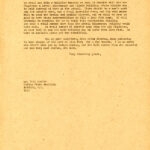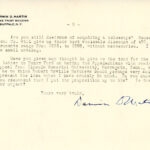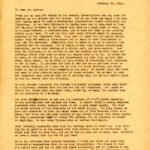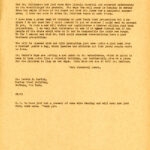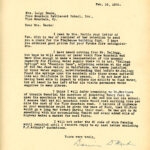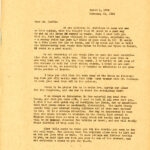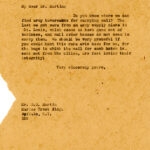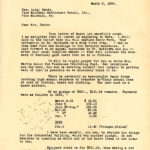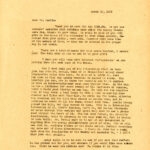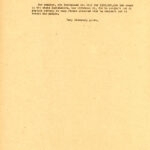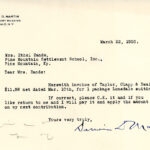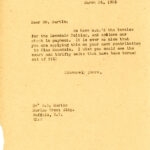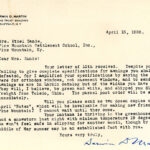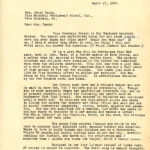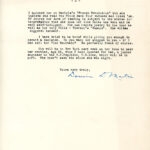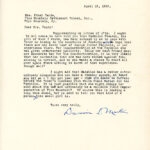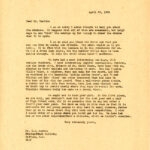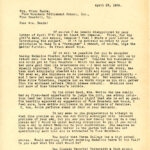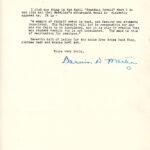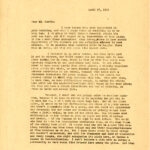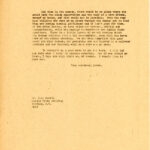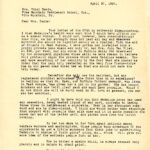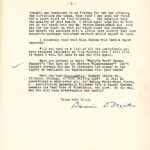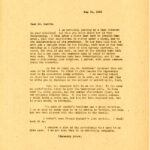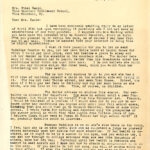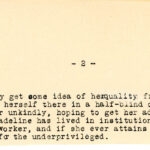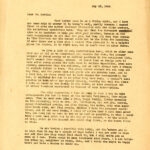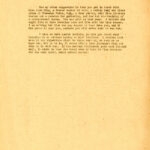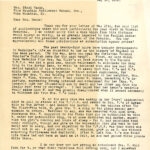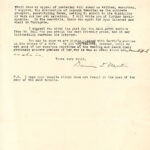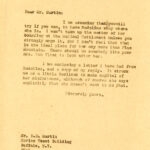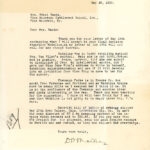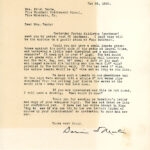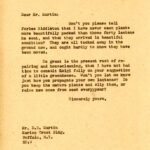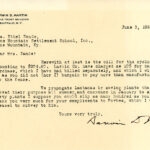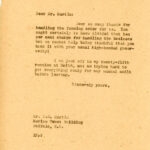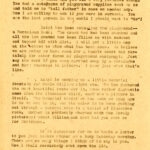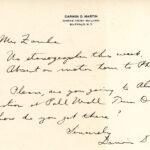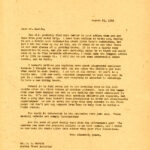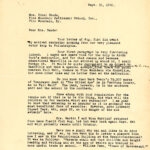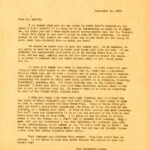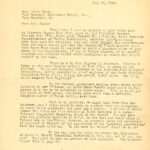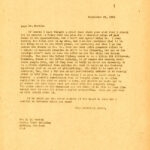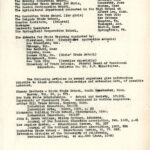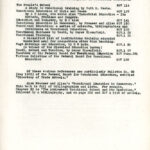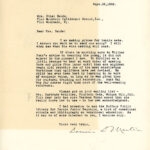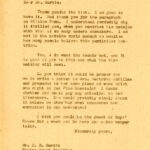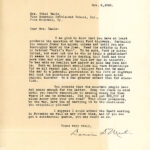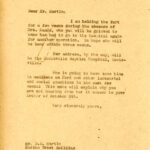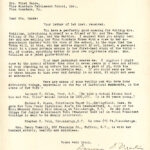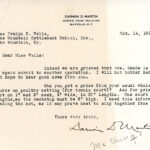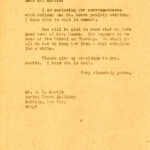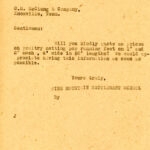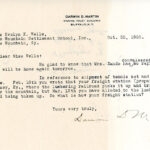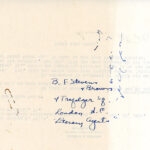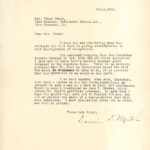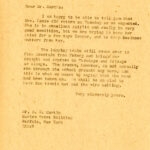Pine Mountain Settlement School
Series 09: BIOGRAPHY
PMSS Board of Trustees
Darwin D. Martin 1926 Correspondence
Member, Board of Trustees 1920-1933
President, Board of Trustees 1920-1929
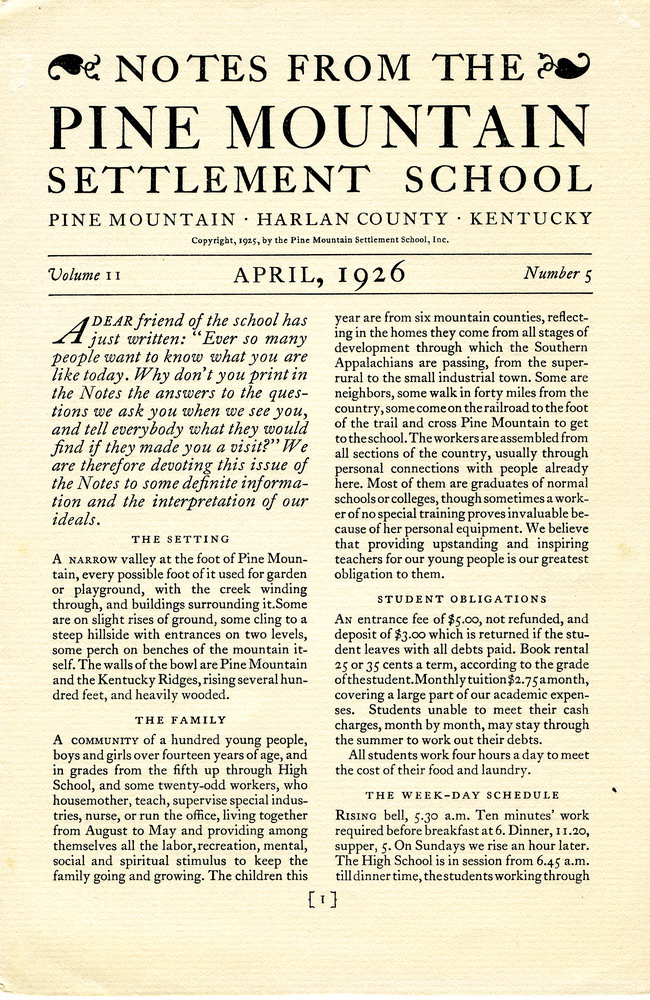
NOTES – 1926 April, page 1. [PMSS_notes_1926_apr_001.jpg]
TAGS: Darwin D. Martin 1926 Correspondence, Pine Mountain Settlement School Board of Trustees, Buffalo, NY history, Ethel de Long Zande, Ethel Zande surgery, industrialization reflections, Notes of the Pine Mountain Settlement School, Charles Kellogg, Playhouse fire, naturopathy, Evelyn K. Wells, golden wedding photo, donations, Line Fork Medical Settlement, mail-order catalogs, invoices, Henry Ford, Lincoln Memorial University, Berea College, road construction, Luigi Zande
DARWIN D. MARTIN 1926 Correspondence
SOME REMARKS ON DARWIN D. MARTIN’S 1926 Correspondence:
GROWING INDUSTRIALIZATION
The correspondence of Darwin D. Martin with Pine Mountain Settlement School in 1926 demonstrates the firm foundation of Martin’s affection for the School and the confidence of the era. By 1926 Pine Mountain had reached a good rhythm in its annual cycles. With the generous help of Darwin D. Martin and his unflagging dedication to the mission of the School, many remarkable changes were occurring at the School and in the growing industrialization of the surrounding coal-rich Harlan County.
The April 1926 NOTES of the Pine Mountain Settlement School, the bi-annual mailing, advises readers that
…[W]ith the incoming industrial era, a desire for better…living and greater beauty of every-day life must be created, or the mountain people will be the victims of circumstance rather than open-eyed choosers of their way of life.
NATIVE AMERICANS AND VISITORS
In the November 1926 Notes, the School’s view was focused in another direction: the way of life in the past. The Native American populations that populated the eastern Appalachians were numerous and hardy. With the new settlers, came disease and large swaths of Native populations were decimated by diseases for which they had no immunity and rarely any cure. The discovery of an Indian burial site at the entrance to the School brought a new awareness to the community of their heritage and their fragility. The dangers of rampant diseases and the difficult journey to develop a Medical Clinic at Big Laurel occupy the School Staff with advice from its Board of Trustees, including Martin.
However, there are snippets of personal news in the letters of Darwin Martin that suggest that the lively life of the Roaring ’20s is not so far removed from the minds of either Martin or PMSS co-director, Ethel de Long Zande. Martin suggests that the naturalist and vaudeville performer, Charles Kellogg might visit the School and hopes he will brave the journey. Martin lauds him for his entertainment as a bird-song imitator whose songs could put out fires – as well as his reputation as a “dowser” (one who finds water sources).
PLAYHOUSE DESTROYED AND ROADS BEING PLANNED
The light banter seen in this series of letters masks the unsettled lives of people, both rich and poor, during this unsettled time. The bulk of the 1926 correspondence is focused on two critical issues at the School. First, the December 1925 fire that destroyed the Playhouse, part of the Medical Settlement at Big Laurel, and secondly, the troubles with a lack of insurance to cover the losses. Also, at Big Laurel, a new medical doctor was arriving in the person of the remarkable Dr. Alfreda Withington. Quickly, she both eases and compounds the tribulations at the new satellite health and community center, four miles from the School. Yet, it is the health of Ethel de Long Zande that dominates at the end of the year, as she begins her long struggle with cancer that kills her just two short years later.
In a series of letters, Martin encourages Zande to explore assistance from Henry Ford for the proposed Pine Mountain Road project. Ethel demures. Henry Ford, who was heavily invested in Harlan County mining becomes a benefactor of major interest during the later Glyn Morris years at the School but was slow to warm to the idea of helping with Harlan County roads unless he could connect his thousands of acres of land in the county. There were no holdings on the north side of Pine Mountain that had few coal prospects. In addition, Zande points out the connections of Ford with Mr. DeWall’s Red Bird School.
AN “INSUBORDINATE AND EXTRA-ORDINARY” GIRL
Complaints by Ethel de Long Zande of the “doings” at Caney Creek are sprinkled throughout the correspondence of Martin and Zande, as are searches for “rara avis,” such as saddlebags used for the local mail runs and other rarities. Martin, in his April letters to Ethel, pleads for another rarity. This, rarity was a rather out-spoken young lady that Martin encountered in Buffalo, NY. He tried vigorously to enroll the “very rare young lady” in the mountain School. He quotes the rules current at the school that “Pine Mountain School is for Kentucky mountain whites. You cannot use contributed money for any other pupils…” Using the quote, he ventures to ask, “Have you ever taken any other sort?” He describes the young girl as “insubordinate” with “extra-ordinary eloquence” and “…can make a winning speech.” It is not surprising to find traits in-common with Ethel de Long Zande.
Ethel, is not persuaded by his reflection, and quickly replies on April 20, that
We ought not to take your girl. In the first place, we are full, and shouldn’t want her for the last year and a half of High School work, for it is possible that we may not offer a fourth year next year. You know we only do this when we feel it is advisable for our young people to stay here in small classes rather than go on to Berea where they will have more competition.
The young girl he describes is Madeline Stanton (not to be confused with the older Madeline Earle Stanton who became an icon at Yale as the Archivist of the Medical School holdings and an expert on early medical history). The girl who concerned Martin so greatly was in another kind of medical community, that of naturopathy therapy in Buffalo, and was apparently fragile and without support from family. Martin came to know her and was impressed by her intellect and potential. For a time, she became Martin’s mission to rehabilitate. In a follow-up letter he again tries to persuade Ethel to consider taking Madeline for only vacation periods at Pine Mountain. He persists
This girl, accordingly [sic] to her own story, has been most singularly cheated all her life all along the line. Yet, even so, she impresses me as possessed of great potentiality — and I have had some opportunity to study her. Her nearest friend, Miss Alice Robertson, regards her as worth while as you will gather from the enclosed letters (which please return). Madeline does not know of Miss Robertson’s letters.
Martin continues with his plea for Miss Stanton by leaning on his wife’s intuitions, which were negative regarding the girl’s potential, but endorsed a Pine Mountain stay for the girl. He writes
It may seem to you preposterous to attempt to wish this problem on you who are fairly submerged with imminent problems of your own, but you see you are really the key to a real puzzle and I would be under lasting obligation to you if you could open a way to admit Madeline to your observation. She assures me that she would be a good worker in the garden but she has not specifically said that she is attracted to Pine Mountain.
Martin then asks for guidance about Berea College as an educational possibility for Madeline and about Lincoln Memorial University at Harrogate, Tennessee, as an alternative institution. His exploration of Lincoln Memorial University was discouraged when he learned of the lack of the university’s sensitivity to naturopathy as outlined in the local Mountain Herald newspaper which noted that
A supply of typhoid serum is kept, and faculty and students inoculated. The University will not be responsible for anyone who fails to be inoculated and it is only by evasion that any student remains who is not inoculated. The same is true of vaccination for smallpox.
COVID AND NATUROPATHY
We are left to wonder how Martin would have greeted the mandatory vaccination for COVID during the 2021-2023 epidemic across the world and more importantly, what his views might have been of the managed vaccination and quarantine exercises at Pine Mountain in the early years and later.
While his views on naturopathy are well represented in his letters, his views on marital responsibility are just as strong. When he learned that the married president of a Tennessee university had recently been asked to resign due to philandering behavior with a faculty member, he removed Lincoln Memorial University from his list of potential placement for Stanton and returned to Berea as the leading prospect. Martin, throughout his letters, displays well-defined social boundaries and reveals much about his personal high values — values shared by the School and standards that kept Martin engaged with Pine Mountain as a ready confidant and Chairman of the Board for nearly ten years and under three Directors.
See Also:
DARWIN D. MARTIN Board – Biography
Return To:
DARWIN D. MARTIN CORRESPONDENCE Guide
ITEMIZED CONTENTS: DARWIN D. MARTIN 1926 Correspondence
[Note: Letters from PMSS staff in the PMSS Collections are carbon copies, typewritten, unsigned, and meant for the Office files. The original signed copies were sent to the correspondents. The initials at the bottom left of most PMSS letters indicate the writer (along with initials of the secretary). For example, “EZ” are the initials for Ethel de Long Zande and “EKW” for Evelyn K. Wells. Letters from Darwin D. Martin are typewritten originals, unless specified otherwise. The following list of contents is in chronological order and not necessarily in the order of the image numbers.]
January 1926
002-003 January 4, 1926. To S.D. Covert, Covert & Workman, NYC, from G.M. Kirby, Larkin Co., Inc., Buffalo, NY. An order for khaki and wool blankets to be sent to PMSS, with invoice to be sent to Larkin Co. & PMSS.
001 January 5, 1926. To Ethel Zande from Darwin D. Martin, Buffalo, NY, enclosing a copy of an order for Covert & Workman to send blankets that Zande had requested. He plans to send prices for 6 enlargements and 36 original small sizes of the “golden wedding photo” (likely a photo of William and Sally Creech in their wedding outfits, celebrating their golden anniversary).
004 January 11, 1926. To Covert & Workman, NYC, from (unsigned), enclosing a check “to save cash discount on your invoice.” An added typewritten note to PMSS from Martin, who is applying the payment on his $500 pledge.
005 January 13, 1926. To Mrs. Martin from (unsigned, likely Zande), thanking her for her letter and the check for Bodie’s tuition. Appreciates the enlargements, but chances of selling them, “even at ten dollars, would be small.” She would like to have a reproduction for her mother who was a close friend of Aunt Sal’s. Tells a story she heard from an extension worker about a 78-year-old teacher in a neighboring district. Thanks the Martins and Miss Herrick for the Christmas cards.
006 January 14, 1926. To Martin from EZ (Zande). She thanks him for paying for the blankets, but is sending a partial reimbursement. Describes the burning of the Playhouse at the Medical Center on December 31, 1925. It was uninsured, according to Mr. Arnspiger; the value was about $1200. It is hoped the neighbors will help with the rebuilding, since “they have been so appreciative of having a big room for gathering in….”
007 January 20, 1926. To Zande from Martin, asking several questions about the Playhouse fire. He has mailed Zande postcard-size golden wedding reprints and states their price.
008-008a January 25, 1926. Two-page letter to Martin from EZ (Zande), [008] thanking him for the golden wedding pictures. She is not ordering enlargements, because neither the School nor visitors would be able to afford them. “My, how we prize the one in the schoolhouse!” She then describes the fire in the Playhouse where Mr. and Mrs. Warren (“a young married couple from Mississippi who teach at Big Laurel school”) live. She explains why the Medical Settlement has no fire protection except hand extinguishers. “The people are very anxious to rebuild” and Mr. Warren is gathering statements of promise to help. About 600 or 700 dollars is needed [008a] for rebuilding. Zande describes ideas for additions to the rebuilt Playhouse. Miss Alice Bingham arrived yesterday to take charge of Line Fork for a few months, but left sooner than she expected.
February 1926
009-009a February 6, 1926. Two-page letter to Zande from Martin, [009] who updates her on the purchase of the wire fencing. Provides a Larkin Co. invoice for “the goods (wringer and 3 Bibles) shipped last order.” He will pay the bill. Mrs. Martin, upset by the Playhouse fire, plans “to send a substantial contribution toward the rebuilding fund.” He asks several questions about fire safety at the Medical Settlement. Charles Kellogg, who has a vaudeville act, may be visiting PMSS.. [009a] If PMSS still wants a telescope, he offers to send a Bausch & Lomb Optical Co. catalog. He asks Zande if she would write a draft “of a letter to Henry Ford on boring the Appalachians with roads.” Robert Orville Matthews at Lincoln Memorial University (Harrogate, TN) may be able to present the idea; Martin asks for Zande’s opinion.
010-010a February 10, 1926. Two-page letter to Martin from EZ (Zande) [010] who thanks him for the “fencing investigation” and for sending the wringer and Bibles. She is happy about Mrs. Martin’s planned donation. She describes the work that Mr. Warren is doing; how the Medical Settlement chimneys are being tested; the fire extinguishers on hand; PMSS’s access to water and the problem of water supply in the mountains. She welcomes a visit from Mr. Kellogg. As for Dr. Matthews, President of Lincoln Memorial, she writes that he could make some interesting suggestions; she describes the current state of Lincoln Memorial’s grounds. [010a] She’s not sure she wants to present a proposition to Henry Ford. She hopes instead that “the road bond proposition will go through so that “the people of the state would vote on it and be responsible for their own roads.” Mentions successful milk production at PMSS, “which insures the children all (the milk) that young people ought to have.” Mr. (Luigi) Zande and his boys are adding a new porch on the schoolhouse, “which is going to make it look quite like a Colonial building.”
011 February 16, 1926. To Zande from Martin, describing Mr. Kelloggs’ “uncanny capacity for finding water supply where it is not.” Martin decided not to approach “Dr. Matthews about inspiring Henry Ford to open the mountains with roads until I can see him and his school.”
013 February 19, 1926. To Martin from EKW (Wells), asking where to “find army haversacks for carrying mail” on horses from the office.
012 February 26, 1926 / March 1, 1926. To Martin from (unsigned, possibly a truncated letter). PMSS will invite Dr. Matthews to visit this spring, “with the thought that it would be a good way to get at his ideas in regard to roads. … Mr. Ford has large holdings in Leslie County, adjoining us. … It would be a fine place for him to begin (building) the inter-county seat roads….” Martin is asked “to make the cash contribution that is left, right now. This is the time of year when we are very hard put to it ….” Writes about the Caney Creek school and Knott County politics. Miss Wells sends her thanks concerning mail-bags.
March-April 1926
014 March 5, 1926. To Zande from Martin, responding to various topics in Zande’s March 1 letter: Henry Ford, Dr. Matthews, Mrs. Martin’s pledge, Caney Creek. He gives an account of 1925-6 payments on his pledge of $500 and enclosing a check to which he added another $100. Mentions his other pledge to the Industrial Building.
015-015a March 12, 1926. Two-page letter to Martin from (unsigned, likely Zande), [015] who thanks him for his check which enabled the School to pay the workers’ salaries. Mentions the “apologia” in the next issue of Notes. Tells about a visit from Mr. DeWall, head of Red Bird School, an Evangelical school about 35 miles from PMSS, who knows “of an offer Mr. Ford made to Clay and Leslie counties in regard to roads (where Ford’s holdings are located).” Zande explains Ford’s offers; Red Bird is on one of the roads. Luigi (Zande) asks whether he should send the four redbuds to Martin. [015a] “Our senator, who introduced the bill for $100,000,000 for roads in the state legislature, has withdrawn it” because it had too many riders.
016 March 22, 1926. To Zande from Martin, providing an invoice of Taylor, Clapp & Beall for a $11.58 package of Lonadale suiting. Martin will pay the bill and apply the amount to his next contribution.
017 March 26, 1926. To Martin from EZ (Zande), giving her okay for the invoice and enclosing a check. “I wish you could see the smart and thrifty suits that have been turned out of it!”
018 April 15, 1926. To Zande from Martin, who describes an awning order; asks for “two dozen copies of your April Notes, which will be invaluable for making new friends for Pine Mountain.”
019-020 April 17, 1926. Two-page letter to Zande from Martin, [019] who describes a young woman (Madeline Stanton), age 21, born in Lynn, MA, who has spent some time at George Junior Republic. She needs about 1 1/2 years of high school to prepare her for college. Martin encloses a list of books she has read. [020] Martin asks if this person can attend PMSS.
021 April 19, 1926. To Zande from Martin, who supplements his April 17th letter concerning Madeline Stanton, including that she is a good speaker.
022 April 20, 1926. To Martin from EZ (Zande), who tells about the latest visitors to PMSS, including an English sea-captain and his Irish wife, friends of Mr. Cecil Sharp; Singing Willie Nolan, a neighbor, a “well-to-do young couple, a doctor and his wife from Boston,” and Virginia Whitmore Kelly. Zande then tells Martin that she must decline accepting the young woman to PMSS and explains her decision.
023-023a April 23, 1926. To Zande from Martin, [023] who asks if she will take Madeline Stanton during vacation only. He describes how PMSS will benefit her. He encloses a letter from a friend of Stanton’s who “regards her as worthwhile.” He asks about Berea’s high school and whether Lincoln Memorial University has a high school course. [023a] He quotes from the April issue of Mountain Herald and gives his opinion on the subject.
024-024a April 27, 1926. Two-page letter to Martin from EZ (Zande). [024] She will be visiting Lincoln Memorial soon. She compares the school to Berea College. Another reason she declined: “…we find that other than mountain children do not assimilate well here. … we have difficulties enough, in making the mining town child and the head-of-the-hollow child happy in the same place; but they all have a common inheritance and way of thinking, on which to build our common life.” Zande describes other difficulties that Madeline would have at PMSS, [024a] particularly during the summer.
025-025a April 30, 1926. Two-page letter to Zande from Martin, [025] who explains that Madeline’s health is such that she would not be able to endure as a summer worker. Instead, she is working in a private home. He addresses the issues that Zande listed concerning Madeline’s adjustment to PMSS. [025a] Martin may send Madeline to PMSS for a short visit. Mentions Horace Kephart, who wrote an article in April World’s Work, as a possible person to appeal for roads in Appalachia. He also mentions Kneeland Ball, Manager of Larkin Co., in Chicago, who contributed to PMSS a hand-power mill for making whole-wheat flour in 1915, and asks if he is still on the PMSS mailing list.
May 1926
026 May 10, 1926. To Martin from (unsigned, apparently Zande), who reports that Lincoln Memorial “is rather under a cloud, due to the indiscretions of the president.” She describes how PMSS has used Kneeland Ball’s donated hand-power mill.
027-027a May 12, 1926. Two-page letter to Zande from Martin, [027], who continues to plead his case for sending Madeline to PMSS, at least for the summer; he offers to pay the costs. [027a] (Page appears to be truncated.)
029-029a May 13, 1926, To Zande from Martin, [029] who thanks her for visiting and reporting on Lincoln Memorial. He gives updates on Madeline who was moved from Mrs. Van Vliet’s to a YWCA which was closer to her doctor; but Madeline left the doctor and returned to Van Vliet’s who offered to care for her instead. Martin doesn’t know if this will be a permanent solution. [029a] Describes his son Darwin’s wife.
028-028a May 15, 1926. Two-page letter to Martin from (unsigned, apparently Zande), [028] who has discussed the issue of accepting Madeline with “our older workers, who understand conditions here.” Although all want to help Martin with the problem, “because of the warm relationship we all feel for you,” they do not feel that Madeline should come for the summer. She cites reasons for this decision: PMSS has many restrictions which aren’t always accepted readily by younger workers or students; summer students are too busy working to provide companionship, etc. She suggests that Madeline could stay at the Medical Settlement, which “is much more like a busy, happy family, living normally in the community, than we are. Dr. (Alfreda) Withington, Mr. and Mrs. Warren, young Mississippi people, and Miss Krauss, the nurse, with whom Madeline would room, are fine people.” Zande will ask them if they would be comfortable with having Madeline. [028a] Her other suggestion is to contact Miss Jane King, a former PMSS worker from last year. She describes the lady, who now lives in Chenango Forks, NY, as one who might have Madeline for the summer.
030 May 19, 1926. To Martin from (unsigned, apparently Zande), who hopes Madeline will stay with Miss King. Zande encloses letters between Madeline and herself. “It struck me as a little inclined to make capital of her misfortunes, although of course she says explicitly that she doesn’t want to do that.”
031 May 19, 1926. To Zande from Martin, who reports that Madeline is “rebelling against Mrs. Van Vliet’s control,” so he has given Miss Jane King’s address to her. Encloses a bill of lading for awnings shipped by Hettrick Mfg. Co., Toledo, OH.
032 May 26, 1926. To Zande from Martin, who has sent her lantanas from a gardener. He suggests building a small lean-to greenhouse against Laurel House and provides measurements. Thanks Zande for her correspondence with Madeline.
033 May 31, 1926. To Martin from EZ (Zande), expressing appreciation for the lantanas and asking questions about their propagation.
June-August 1926
034 June 3, 1926. To Zande from Martin, enclosing the bill for the cyclone fencing, having paid the handling charge himself. He answers her question about lantanas.
035 June 9, 1926. To Martin from EZ (Zande), thanking him for the fencing order. She is leaving for her 25th Smith College reunion.
036 July 24, 1926. To Martin from EZ (Zande), who describes Luigi (Zande)’s work on extending the playground and building a memorial fountain for Uncle William (Creech) with rocks from the limestone cliff.
041 July 24, 1926. To Zande from Martin, who writes about articles he has read concerning good roads and their connection to education. He continues to feel that Henry Ford “would be inspired to build roads in the Appalachians if you or Horace Kephart, or an equally inspired and informed writer would assimilate my vision….” He suggests several names of such writers. Martin asks if Zande is going to attend the dedication of Alvin C. York’s Industrial Institute.
037 August 23, 1926. Handwritten letter to Zande from Martin, asking if she is going to Alvin York’s dedication at Pall Mall, TN.
038 August 31, 1926. To Martin from (unsigned, Zande). She has requested more information about the dedication, but will attend if she knows Martin will be there. Hopes to add a tennis court to the playground; swimming and a new diving board have been popular lately. School has started and the homesick students have left to be replaced by other students. “It’s not surprising that mountain children get homesick but what a pity that they haven’t been disciplined to stick out disagreeable experiences!….” Mentions extension work and the country schools.
September-November 1926
039 September 10, 1926. To Zande from Martin, who will not attend the dedication. He urges Zande to go ahead and order a tennis net but asks about rackets. Asks if there is a student who can do the lettering for a placard he has in mind displaying a quote from William Penn.
040 September 15, 1926. To Martin from (truncated, Zande), who tells of plans for a tennis net and perhaps donations of second-hand rackets. Mr. Zande is teaching a mechanical drawing class. Asks if there was more to the Penn quote, as “It doesn’t seem to me half as inspiring as some of the things Uncle William said.” She describes the raising of log walls of Uncle William’s and Aunt Sal’s house and the comments of the sons who helped with the project.
042 September 28, 1926. To Martin from EZ (Zande), who has been pondering Martin’s idea to present a road plan to Henry Ford. She states the reasons she is “not convinced that it is the thing to do in the first place, and certainly not that I am the person who should do it.”
043-043a N.D. (Enclosure in Martin’s September 28, 1926 letter.) “List of Vocational Schools Published in Prosser and Allen’s ‘Vocational Education in a Democracy,’ 1925.” Also included is a list of “articles in recent magazines that give information relative to trade schools, scholarships and extension work, of possible interest.” [043a] And a list of “books [that] give information relative to vocational guidance, industrial training for boys, experiments in various types of continuation schools and development of vocational education.”
044 September 28, 1926. To Zande from Martin, giving his opinion of “reformers” doctrine of “sparing boys and girls from labor until they are eighteen years old….” Asks that Mrs. Gertrude Achilles of Morgan Hill, CA, is added to the PMSS mailing list. Martin encloses a copy of a list of vocational schools and bibliography on vocational education (see 043-043a) from the Buffalo Public Library.
045 October 1, 1926. To Martin from EZ (Zande). Agrees with Martin’s contrasting William Penn’s ”opinion with that of so many modern educators.” Asks for advice about writing a letter to Mrs. Achilles.
046 October 5, 1926. To Zande from Martin, who addresses her points about Ford and suggests she read an article on Ford in October World’s Work. Martin praises Ford’s work and feels he could be “the key to a ‘peaceful penetration’ in the form of highways and that the mountains have to depend upon alien capital therefore to a far greater extent than for education. … Did you not put $25,000 of alien money into your own road?”
047 October 11, 1926. To Martin from EKW (Evelyn K. Wells, Secretary), who reports that Mrs. Zande is in the Louisville Baptist Hospital for another operation. “She is going to have some time to meditate on Ford and other industrial and social questions in the next few weeks.”
048 October 11, 1926. To Zande from Martin, who gives advice on what to include in a letter to Mrs. Achilles, such as a copy of Pine Mountain Notes. He lists “names of some wealthy men who have done altruistic things…in the state of New York.”
049 October 14, 1926. To Evelyn K. Wells from Martin, who is sorry to hear about Mrs. Zande. He asks Wells for” a price from your usual hardware source on poultry netting (for tennis court).”
051 October 18, 1926. To C.M. McClung & Company, Knoxville, TN from (unsigned), requesting quotes of prices on poultry netting.
050 October 22, 1926. To Martin from EKW (Wells), enclosing correspondence with McClung and Co. about poultry netting. Mrs. Zande will return Tuesday. “We shall do all we can to keep her from a full schedule for a while.”
052 October 25, 1926. To Wells from Martin, who is glad to know that Mrs. Zande will return to PMSS soon. He asks if the lumbering railroad is available to bring the shipment of tennis net and poultry wire to PMSS from Putney, KY.
053 October 29, 1926. To Martin from EKW (Wells), reporting that Mrs. Zande has returned as expected. Wells explains that “(t)he logging train still comes over to Pine Mountain from Putney and brings our freight and express on Tuesdays and Fridays as always. The tracks, however, do not actually run through the school grounds any more….”
054 November 6, 1926. To Zande from Martin, who hopes she is recovering to her full strength. He encloses a clipping from the Christian Science Monitor of October 30, that refers to “Henry Ford’s already aroused great interest in the mountain folk.” He continues to hope she will write a letter to Ford, “sumptuously bound by such a bookbinder as John F. Grabau.”
GALLERY: DARWIN D. MARTIN 1926 Correspondence
- 001 martin_darwin_1926_001
- 002 martin_darwin_1926_002
- 003 martin_darwin_1926_003
- 004 martin_darwin_1926_004
- 005 martin_darwin_1926_005
- 006 martin_darwin_1926_006
- 007 martin_darwin_1926_007
- 008 martin_darwin_1926_008
- 008amartin_darwin_1926_008a
- 09a martin_darwin_1926_009a
- 010 martin_darwin_1926_010
- 010a martin_darwin_1926_010
- 011 martin_darwin_1926_011
- 012 martin_darwin_1926_012
- 013 martin_darwin_1926_013
- 014 martin_darwin_1926_014
- 015a martin_darwin_1926_015
- 015a martin_darwin_1926_015
- 016 martin_darwin_1926_016
- 017 martin_darwin_1926_017
- 018 martin_darwin_1926_018
- 019 martin_darwin_1926_019
- 020 martin_darwin_1926_020
- 021 martin_darwin_1926_021
- 022 martin_darwin_1926_022
- 023 martin_darwin_1926_023
- 023c n_darwin_1926_023
- 024 martin_darwin_1926_024
- 024 martin_darwin_1926_024a
- 025 martin_darwin_1926_025
- 025a martin_darwin_1926_025a
- 026 martin_darwin_1926_026
- 027 martin_darwin_1926_027
- 027a martin_darwin_1926_027a
- 028 martin_darwin_1926_02
- 028a martin_darwin_1926_028a
- 029 martin_darwin_1926_029
- 029a martin_darwin_1926_029a
- 030 martin_darwin_1926_030
- 031 martin_darwin_1926_031
- 032 martin_darwin_1926_032
- 033 martin_darwin_1926_033
- 034 martin_darwin_1926_034
- 035 martin_darwin_1926_035
- 036 martin_darwin_1926_036
- 037 martin_darwin_1926_0370
- 038 rtin_darwin_1926_038
- 039 martin_darwin_1926_039
- 040 martin_darwin_1926_040
- 041 martin_darwin_1926_041
- 042 martin_darwin_1926_042
- 043 martin_darwin_1926_043
- 043a martin_darwin_1926_043a
- 044 martin_darwin_1926_044
- 045 martin_darwin_1926_045
- 046 martin_darwin_1926_046
- 047 martin_darwin_1926_047
- 048 martin_darwin_1926_048
- 049 martin_darwin_1926_049
- 050 martin_darwin_1926_050
- 051 martin_darwin_1926_051
- 052 martin_darwin_1926_052
- 052a martin_darwin_1926_052a
- 054 martin_darwin_1926_054
- 053 martin_darwin_1926_053
See Also:
DARWIN D. MARTIN Board – Biography
GOVERNANCE Guide
Return To:
DARWIN D. MARTIN CORRESPONDENCE Guide

